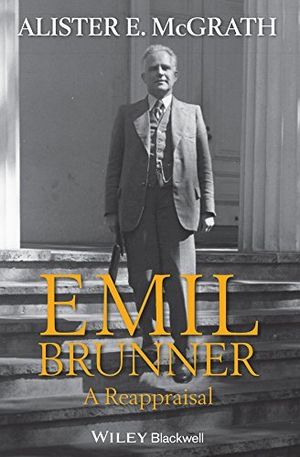Alister McGrath has written a masterly biography of the distinguished and influential Swiss theologian and professor, Emil Brunner (1889-1966). If you studied theology in the 1970s or 80s, Brunner’s name would have soon come up.
Who then, was Emil Brunner? He was the dominant writer for the revolutionary new currents of German theology that began flowing after World War I. Karl Barth was another key figure and the revolution is often called ‘Neo-orthodoxy’.
This label is rejected by McGrath — rightly, in my view (it does no justice to the sheer complexity of what was taking place in German theology). Brunner, although connected with Barth, was by no means his disciple, but an independent thinker.
Thanks to Brunner’s facility with the English language, he was able to impact Britain and America more widely than Barth. Many traditionally Reformed believers in the 1930s-60s found Brunner helpful. I will never forget, in the first Reformed church I attended, how the pastor would often solemnly quote ‘Professor Brunner of Zurich’ to support a point he was making.
A sketch of Brunner’s background may be useful. The disaster of the Great War led to the general collapse of liberal theology in German-speaking lands, including Brunner’s Switzerland. He was a native of Winterthur, near Zurich, and a member of the Swiss Reformed Church.
Like Barth and so many others in the German-speaking world, the young Brunner found that 19th century liberal theology had no response to the insane militarism, nationalism and orgy of inhuman destruction unleashed within ‘Christian’ Europe in 1914.
He began looking elsewhere for instruction and inspiration; among his new mentors were the Protestant Reformers, with their dark perception of human sin and their faith in a Christ who was not merely the noblest of men.
Not that Brunner was a slavish devotee of Luther or Calvin. Indeed, we might wish he had been a little more slavish. Despite the largely Reformational tone of Brunner’s theology, he was never able to accept the verbal inspiration and inerrancy of Scripture. This led him to question Matthew and Luke’s account of the virgin birth as incompatible with Jesus’ true and full humanity.
Despite not wholly embracing the ‘old’ Protestant orthodoxy, Brunner brought to a global audience a robust critique of 19th century liberalism with its ambivalence about Christ’s deity, its optimistic view of man, its rejection of substitutionary atonement and its enthronement of experience as the supreme religious authority. To read or hear Brunner on these themes was indeed to encounter the voices of Luther and Calvin, not to say Paul and John, speaking afresh.
Brunner’s best-known works along these lines were The Mediator (1934) and Man in Revolt (1937). The first is an eloquent re-stating of the uniqueness of Christ as the God-Man and his substitutionary, wrath-bearing sacrifice as the true meeting-place between a holy God and unholy sinners.
The second is Brunner’s ‘take’ on the doctrine of original sin, which he affirmed strongly. Brunner was, however, not so successful in setting out sin’s doctrinal underpinnings, since he was less than convinced of an historical fall.
Brunner also highlighted the need for Christians to have a well-thought-out ‘doctrine of society’, perhaps still needed today. His rich theological thinking on society, the state, economics, the citizen, the family and related themes, is found most fully in his The Divine Imperative (1932).
Brunner further emphasised the need for Christians to engage in apologetics: understanding the times, perceiving their bearings on Christian faith and life and offering a careful Christian response.
Putting on blinkers and just shouting the gospel at society is no Christian method or attitude, for Brunner. His Revelation and Reason (1941) pursues this topic. It is this side of Brunner that appeals most strongly to McGrath, well-known himself as an apologist.
Perhaps Brunner’s most fruitful and edifying work was his little Our Faith (1936), his own personal favourite. This is a straightforward, sermon-like introduction to the full spectrum of Christian beliefs.
It is pastoral in orientation, powerful in application and almost wholly free from the less orthodox aspects of Brunner’s thinking. I have returned to it repeatedly and with much profit.
What then shall we make of all this? Firstly, McGrath has undoubtedly produced an outstanding introduction to Brunner, focusing on the man’s theology and helpfully translating all cited passages afresh from the German.
It is a thoroughly readable immersion into Brunner’s world, times, relationships, and thinking. To understand Protestant theology in the period of the world wars, this study of Brunner is highly valuable.
Secondly, should we read Brunner today? I would not recommend him to the young believer, owing to his shakiness on the inspiration and infallibility of Scripture. Even the believer settled in his faith should be aware that Brunner does not represent historic Reformed orthodoxy.
That said, there is no denying that mature believers often find large parts of Brunner’s work immensely stimulating. He is always original, never just parroting the past, so that when he does embrace traditional doctrine, you know it has followed serious and strenuous personal wrestling.
Brunner’s brilliant mind and vast breadth of learning, his deep insight into history and modern culture, combined with his warm, human heart, give him an unusual power to communicate truth in a vital and relevant way to those prepared to hear him with discernment.
Rev. Dr Nick Needham
Inverness



